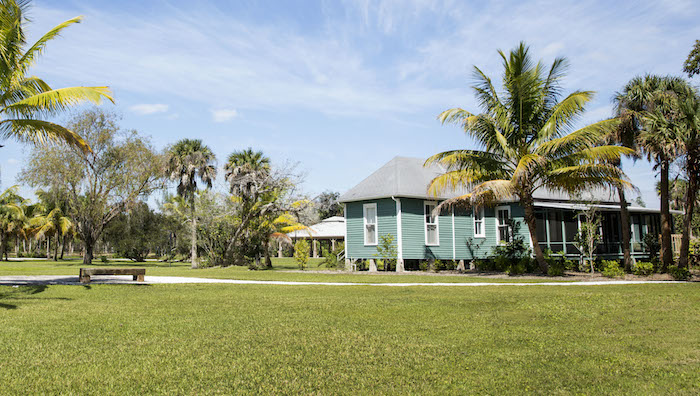When the legendary Bailey family homestead went up for sale, the Sanibel community had two choices: help preserve an important part of the sanctuary island or allow another 36 homes to take up residence. Here’s the story of how wildlife and nature were saved at the “eleventh hour.”
The year was 1895. Mary Bailey was living in Kentucky with seven children when, for reasons unknown, she moved to Sanibel Island with three of her adult sons — Earnest, Francis and Harry. Originally from Virginia, they came to farm in a frost-free environment, but quickly found the small, sandy plot of land they had purchased a challenge for many crops. So, they built a small house, settled in and went about planting watermelon, peppers and tomatoes while nurturing citrus and working whatever jobs they could find.
During that time, a friendly relationship developed with an Island Inn guest and in 1899, the guest granted them use of a dock at the bay’s edge of what is today Bailey Road — and the original Bailey general store was founded by 28-year-old Frank, providing seed and supplies to the island by way of mail boats that arrived three times each day.
Enjoy this story with images online now with our digital COASTE magazine.
Over the years, the Bailey businesses prospered and the family grew. When ferryboats began bringing residents and guests to the islands, their first stop was most often the expanding store for provisions. And back at home, Francis’ family grew too — adding bedroom after bedroom as one after another child was born (including island legends Sam and Francis, Jr.), which is why the house is 90 feet long.
Then along came 1963, when the drawbridge and causeway from Punta Rassa to Sanibel opened to traffic and the islands changed forever. In response, Bailey’s General Store relocated to its current location three years later. But the Bailey home along Periwinkle Way remained, in fact expanding over the years to 28 acres.
Throughout the years, Sam and Francis Bailey played the roles of the island’s “first family” naturally, gracefully and generously. But time marches on, and in June, 2010 the 86-year-old Sam died of natural causes. It was then that Francis continued the family legacy of community first, and offered Sanibel Captiva Conservation Foundation (SCCF) right of first refusal for the Bailey home’s 28 acres. The price? An amazing $4 million for property worth tens of millions more if developed. The catch? The Foundation had one year to raise the funds.
“There would have been room for 36 houses on that property,” says Kristie Anders, education director for SCCF for the past 28 years. “This would have absolutely gone public if we hadn’t raised the money.”
Quickly then, under the leadership of SCCF executive director Erick Lindblad and legacy coordinator Cheryl Giattini, a true grass roots campaign developed. Because the property remained private, no tours could be given. Instead, SCCF took to public gatherings, private meetings and media relations to spread the important word on the value of the Bailey homestead to Sanibel’s way of life.
“When we looked at a map of the island, we realized that with the purchase of this land, wildlife would literally have an open corridor along the bayside to migrate — from the Chamber of Commerce area to the eastern edge of Ding Darling National Wildlife Refuge — with only two quiet streets to cross. It was the missing piece and our motivation. Our mission is the preservation of coastal habitats and aquatic resources, and that was our push, not to mention as preserved land goes up, flood insurance goes down.”
But the Bailey homestead was challenged by a variety of non-native invasive plant species — so in order to bring the property to a level both accessible and inhabitable by wildlife (an SCCF mandate), another $2 million was needed by the June, 2011 deadline to make the transaction complete. And it all happened at the “eleventh hour.”
“We were close to not making our goal,” Anders recalls. “But in the end, we did, because there were thousands of people who supported this campaign. We had gifts from $20 to $1 million.”
Unfortunately, Francis Bailey wouldn’t live to admire the restoration of his family’s homestead to its full vision, passing in 2013. But quite a restoration it is (and continues to be). The property is a mix of wetlands and uplands, and native plantings by SCCF experts are able to imitate every type of habitat on Sanibel. The SCCF Native Landscape & Garden Center has also relocated here, open Monday to Saturday selling native plant species.
Although the home isn’t open for regular tour, the Bailey Homestead Preserve is open for pleasant walks and exploration six days a week and is a beautifully restored slice of Sanibel’s ecology, geography and history.
“Each person who contributed to our campaign shares the same believe as SCCF, that preserving our wildlife habitat is vital,” Anders says. “Next year we’ll celebrate our fiftieth anniversary, and when you look at our official mission from some 50 years ago, we’re still doing what we promised we’d do.”
www.SCCF.org
— Story by John Sprecher | Images by Milissa Sprecher Photography

